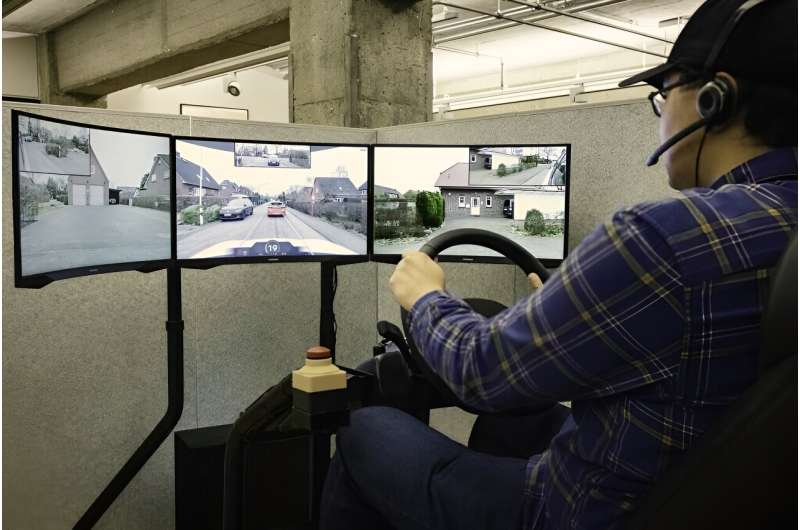
At a time when the general public may not yet accept driverless taxis and ride-hailing vehicles, teledriving could offer many of the same benefits, according to a new study led by a University of Michigan researcher. The research is published in the journal Management Science.
With more cars on the road, fewer drivers and fewer riderless miles, ride-sharing services could become faster and more affordable.
Teledriving typically involves a driver operating a car while sitting in front of a bank of screens that show video feeds from cameras on the car, as well as sensors and augmented reality technology. Once a passenger has been picked up, transported and dropped off, the driver can disconnect from that vehicle and connect to any other that is available in an area of need. Several private teledriving companies are already in operation, including Halo.Car and Vay in Las Vegas.
One of the main advantages of teledriving, according to researchers led by Saif Benjaafar, U-M professor of industrial and operations engineering, is that drivers do not need to be where the vehicles are—for instance, driving from areas of low demand to areas of high demand with no rider. In this vein, teledriving can eliminate what ride hailing services refer to as the 'wild goose chase' scenario. At times when vehicle supply is low, cars need to be dispatched to customers located far away even if it's not the most efficient pairing between rider and driver.
"Teledriving allows you to get away with far fewer drivers than vehicles without impacting the quality of service because you can still leverage the excess vehicles to get quickly to customers—a reduction of 30% to 40% in some of the test cases we considered," said Benjaafar, who specializes in supply chains and logistics.
"There's an opportunity to significantly increase how busy the drivers are. One of the challenges for ride services has always been having drivers who are sitting idle. Quite a bit of that inefficiency can be eliminated."
The remaining drivers also stand to benefit as this system would shift vehicle ownership, and the cost and risk that it entails, onto the rideshare company. Teledriving may broaden labor participation as driving becomes a desk job, the researchers suggest.
Finally, the team is optimistic that the separation of drivers and riders could improve the safety of both, particularly women who have been disproportionately the targets of in-vehicle assault and other criminal behavior. However, teledriving systems also need to guard against reckless driving in a work environment that feels more like a video game.
Using computer modeling that factors in supply, demand and road congestion over both time and space, researchers showed that a higher number of available vehicles than drivers can shorten wait times in periods of high demand, even with fewer drivers. This is because the likelihood of a driver going on a wild goose chase is reduced.
"This research can be applied to the world/community by improving the efficiency and cost-effectiveness of ride-hailing and other on-demand transportation services," said Xiaotang Yang, a postdoctoral fellow at the University of Toronto's Rotman School of Management.
More information: Saif Benjaafar et al, Human in the Loop Automation: Ride-Hailing with Remote (Tele-)Drivers, Management Science (2024). DOI: 10.1287/mnsc.2022.01687
Citation: Not quite ready for autonomous taxis? Teledriving could be a bridge (2024, June 20) retrieved 20 June 2024 from https://techxplore.com/news/2024-06-ready-autonomous-taxis-teledriving-bridge.html
This document is subject to copyright. Apart from any fair dealing for the purpose of private study or research, no part may be reproduced without the written permission. The content is provided for information purposes only.
